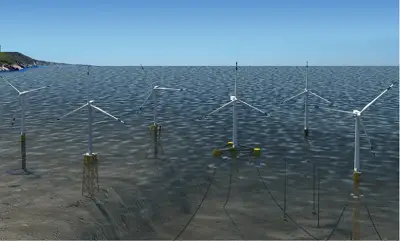 Problems
at Wind Turbines and Farms
Problems
at Wind Turbines and FarmsWhile wind turbines are generally considered a clean and renewable source of energy, there are a few environmental and other concerns associated with their use. Ocean wind farms are being questioned with regard to their potential effect on whales and dolphins, and now land wind farms are being questioned. It's important to note that these concerns vary in significance depending on the location, design, and management of wind turbine projects.
Here are some of the common issues associated with wind turbines:
Wind turbines can pose a risk to birds and bats, especially when located in migration routes or habitats with high wildlife activity. Collisions with rotating turbine blades can result in injuries or fatalities for these animals. However, it's worth noting that the impact on bird and bat populations is relatively low compared to other human-made structures such as buildings and communication towers.
Nonetheless, the Committee on the Status of Endangered Wildlife in Canada, an independent body that reports to the federal government , on May, 22,2023 says " “the mortality at wind farms seems to be the top threat” to the hoary bat, the silver-haired bat and the eastern red bat. Studies in 2019 say that each turbine kills approximately 10 bats per year, which adds up to tens of thousands of individual bats killed each year in Canada alone.
Connexion France reports (December 2023) a windfarm in Lunas, southern France, operated by Énergie Renouvelable du Languedoc (ERL), a subsidiary of the German group EnW, has been ordered to shut down by the Nîmes Court of Appeal. This marks the first closure of its kind in the country due to noise complaints from residents and concerns about its impact on birds, specifically the golden eagle ('aigle royal' in French). Here are key facts:
Wind turbines generate some level of noise during operation, which can be a concern for nearby residents, particularly if the turbines are located in close proximity to homes or sensitive areas. Additionally, the visual impact of wind turbines on the landscape is subjective, and some people may find them visually intrusive.
Wind farms require large areas of land for installation, which can result in the conversion of natural habitats or agricultural lands. This land use change can lead to habitat fragmentation and potentially disrupt local ecosystems. Careful site selection and planning can help minimize these impacts.
Some individuals living in close proximity to wind turbines have reported health issues such as sleep disturbances, headaches, and annoyance due to low-frequency noise or infrasound generated by the turbines. However, scientific studies have not consistently found a direct causal link between these health effects and wind turbine operation.
The development of wind farms can sometimes create conflicts within local communities. Concerns about property values, impacts on tourism, and disagreements over the distribution of economic benefits can arise. Effective community engagement and transparent decision-making processes can help address these concerns and foster positive relationships.
Wind turbines require the use of materials and energy during manufacturing, which may have associated environmental impacts. Additionally, decommissioning and recycling of wind turbine components at the end of their lifespan can pose technical and logistical challenges.
Beyond the environmental issues noted above, and the obvious problem of "they don't go, when the wind don't blow", there a host of practical problems with wind energy.
The Danish energy company
Ørsted announced
that it would pull out of a billion-dollar project to build wind turbines off the New Jersey coast. Ørsted said, “Since the announcement,
the US offshore wind projects have experienced further negative developments”. The project, called Ocean Wind, was a two-phased development
that would have provided power to around 1 million people. Plans for Ocean Wind 1 had been in the works since 2019 and called for as many as 98
offshore wind turbines reaching more than 850 feet about 15 miles from the coasts of Cape May and Atlantic Counties. Ørsted was required to place a
$200 million guarantee into state coffers, which will ostensibly be returned to ratepayers now that the company has scrapped the project.
It's worth noting that many of these concerns are actively addressed through careful project planning, environmental impact assessments, and ongoing research to improve turbine design and minimize potential impacts. Wind energy remains one of the most environmentally friendly forms of electricity generation, playing a crucial role in transitioning to a cleaner energy future.
Many references and sources are included in the text above. Below are others:
Ways to save money AND help the environment:
Eat healthier AND save money: Instant Pot Duo Crisp 11-in-1 Air Fryer and Electric Pressure Cooker Combo with Multicooker Lids that Fries, Steams, Slow Cooks, Sautés, Dehydrates
Save water AND money with this showerhead adapter, it lets the water flow until the water is hot, then shuts off water flow until you restart it, ShowerStart TSV Hot Water Standby Adapter
Protect your health with these:
Mattress Dust mite-Bedbug protector, 100% Waterproof, Hypoallergenic, Zippered
Handheld Allergen Vacuum Cleaner with UV Sanitizing and Heating for Allergies and Pet, Kills Mite, Virus, Molds, True HEPA with Powerful Suction removes Hair, Dander, Pollen, Dust,
Immune Support Supplement with Quercetin, Vitamin C, Zinc, Vitamin D3
GermGuardian Air Purifier with UV-C Light and HEPA 13 Filter, Removes 99.97% of Pollutants
5 Stage Air Purifier, Features Ultraviolet Light (UVC), H13 True Hepa, Carbon, PCO, Smart Wifi, Auto Mode, Quiet, Removes 99.97% of Particles, Smoke, Mold, Pet Dander, Dust, Odors
Interesting Reads:
THE PREPPER'S CANNING & PRESERVING BIBLE: [13 in 1] Your Path to Food Self-Sufficiency. Canning, Dehydrating, Fermenting, Pickling & More, Plus The Food Preservation Calendar for a Sustainable Pantry
The Backyard Homestead: Produce all the food you need on just a quarter acre! Paperback
The Citizens' Guide to Geologic Hazards: A Guide to Understanding Geologic Hazards Including Asbestos, Radon, Swelling Soils, Earthquakes, Volcanoes
The Uninhabitable Earth: Life After Warming
Book: The Sixth Extinction: An Unnatural History Paperback